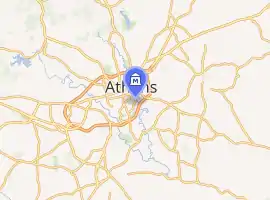Georgia Museum of Natural History
Georgia Museum of Natural History is the U.S. state of Georgia's museum of natural history located in Athens.[1] The science portion of the museum has fourteen different collections in Archaeology, Arthropods, Botany Herbarium, Economic Geology, Herpetology, Ichthyology, Invertebrate Biology, Mammalogy, Mycological Herbarium, Ornithology, Paleontology, Pollen and Plant Microspore, Rocks and Minerals, and Zooarchaeology,[2] as well as more than 325,000 ethanol-preserved fish and other animal specimens.[3] These alcohol-preserved tissues provide greater accessibility for evaluation of genomic diversity in these specimens. In addition, there are exhibits, archives, and entertainment for children.[4] Its more than seven million objects makes it one of the largest museums in the Southeast.[5] The museum's webpage is one of the most visited on the University of Georgia website.[6]

| |
| Location | Athens, Georgia, United States |
|---|---|
| Website | Georgia Museum of Natural History |
History
The museum was formally recognized by the University in 1978 as the Museum of Natural History. In 1999 the Georgia General Assembly recognized it as the official state museum of natural history, naming it the Georgia Museum of Natural History. The history of the museum goes much farther back, however. The museum's first collections date back to the early 1800s as professors and students alike collected specimens to aid in understanding the natural world around them. UGA's first professor, Josiah Meigs, began a collection between 1801-1810. Overtime, the collections continued to grow and moved across campus multiple times. The museum was also closely associated with the University's library and botanical garden.[7]
Internship Program
The museum also offers an internship program for students to gain experience working with the museum collections in the fall, spring, and summer semesters. Interns work with collections staff collecting, accessioning, preparing, cataloging, and curating natural history collections. Collections available for internships are: Archaeology, Arthropods, Botany, Economic Geology, Herpetology, Genomics and Marine Invertebrates, Ichthyology, Invertebrates, Mammalogy, Mycology, Ornithology, and Zooarchaeology. Interns may also participate in tours, outreach presentations, special events, preparation of displays, and field trips.[8]
See also
References
- "Information". Georgia Museum of Natural History. 2008. Archived from the original on May 12, 2008. Retrieved 2008-05-17.
- "Collections". Georgia Museum of Natural History. 2008. Archived from the original on May 12, 2008. Retrieved 2008-05-17.
- "FAQ". Georgia Museum of Natural History. 2008. Archived from the original on September 25, 2007. Retrieved 2008-05-17.
- "Exhibit". Georgia Museum of Natural History. 2008. Archived from the original on May 9, 2008. Retrieved 2008-05-17.
- "Museum is a cram course on natural history: UGA lacks the space to display collections". The Atlanta Journal. April 6, 1985.
- "Public role sought for natural history museum". Morris News Service. March 7, 2000. Retrieved 2008-05-17.
- "Museum History". Museum History. Retrieved May 27, 2020.
- "Internship Information". Internship Information. Retrieved May 27, 2020.